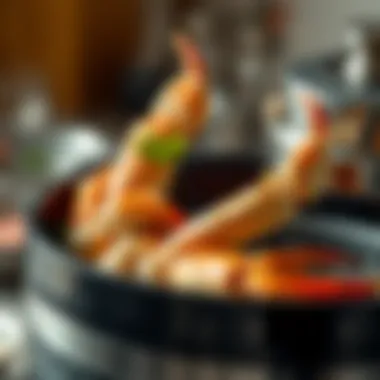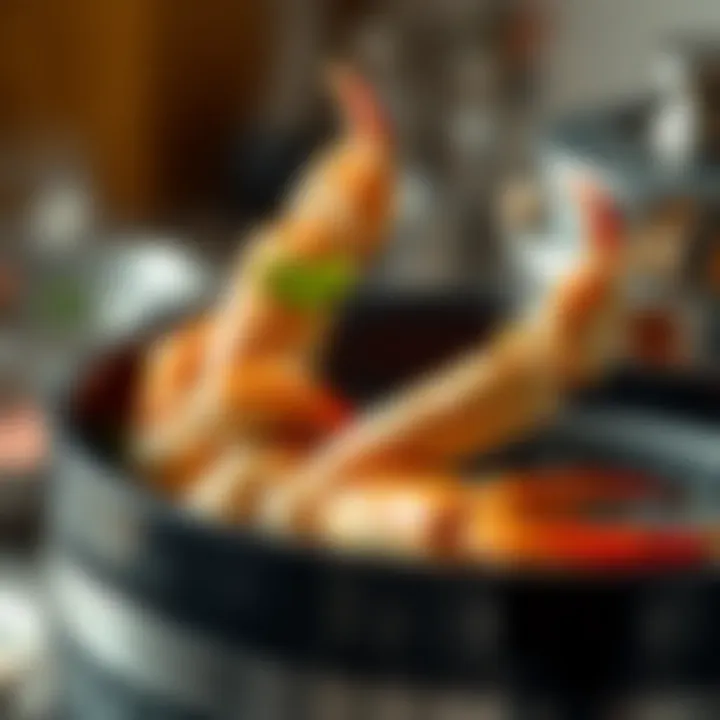Choosing the Best Steamer for Cooking Crab Legs


Intro
In the realm of seafood preparation, few delights match the tender, sweet meat of crab legs. If you’ve ever sat down to a feast of succulent crab, you know just how important it is that they are cooked to perfection. One of the most time-honored methods to achieve this is steaming, a technique that locks in flavor and moisture while preserving that delicate texture we all crave.
However, the key to achieving the best outcome lies in the steamer you choose. With a plethora of options available out there, navigating through the choices can feel akin to finding a needle in a haystack. Whether you're a seasoned culinary wizard or just dipping your toes into the world of cooking, understanding the nuances of selecting the right steamer for cooking crab legs is critical.
This guide will serve as your compass, pointing out not only the various types of steamers but also the essential features you should be on the lookout for. We won't stop at mere selection; expert cooking tips and maintenance advice will ensure your steaming experience is nothing short of a success.
Let’s dive in!
Foreword to Steaming Crab Legs
When it comes to enjoying seafood, few delights rival the experience of savoring freshly steamed crab legs. The process of steaming crab legs doesn’t just maintain their natural flavor, it also preserves their enticing texture, making each bite a culinary joy. In this article, we unravel the art of selecting the optimal steamer specifically for crab legs, providing essential insights to elevate your cooking experience.
The Importance of Steaming
Steaming is an age-old method that, while simple, brings remarkable benefits to crab leg preparation. Unlike boiling, which can leach flavorful juices into the water, steaming retains the essence of the crab and enhances its taste without needing excess seasoning. This method relies on the gentle application of heat, ensuring that the meat remains tender and juicy, setting the stage for an exquisite seafood dish.
Steaming isn’t just about taste; it’s also a health-conscious choice. Many cooking methods require additional fats or oils, but with steaming, all you need is water. It simplifies the process without sacrificing flavor, which appeals to both health enthusiasts and food lovers alike.
What to Consider
Selecting the right steamer can be daunting, especially with the range of options available on the market today. Factors like size, material, and design come into play. A well-chosen steamer can make the difference between lackluster and memorable crab legs. This article will delve into various types of steamers, key features to look for, and tips to ensure you achieve perfect results every time.
By the end of this discussion, you’ll be equipped with the knowledge to choose the ideal steamer tailored to your cooking style. So let’s dive into the intricacies of steaming crab legs and discover why this method is revered in kitchens around the world.
Understanding Steamers
When it comes to preparing delicious crab legs, selecting the right steamer can significantly impact your cooking experience. Understanding steamers is paramount as it equips you with the knowledge to make an informed decision based on your needs and preferences. They come in various shapes and sizes, each with distinct advantages and drawbacks. Additionally, certain features may enhance your overall cooking experience, preserving the delicate flavor and texture of your seafood delicacies.
In this section, we will explore the types of steamers available and the key components that make a steamer suitable for cooking crab legs. Knowing these details can turn a merely okay seafood feast into an extraordinary culinary triumph.
Types of Steamers
Traditional Stovetop Steamers
Traditional stovetop steamers are often considered the classic choice for preparing crab legs. These steamers typically consist of a pot with a steaming basket that sits above simmering water, using steam to cook your food. One of the key characteristics of stovetop steamers is their simplicity. They require no electricity and are often constructed from stainless steel or aluminum, providing durability and efficient heat conduction.
A unique feature of these steamers is the ability to control heat manually, allowing you to adjust cooking times precisely. However, on the downside, they can require a bit of attention during cooking to ensure that the water doesn’t evaporate completely, which could result in burnt food.
Electric Steamers
Electric steamers represent a modern twist on classic steaming techniques. They are self-contained units that plug into an outlet and typically include multiple tiers, allowing you to steam various ingredients simultaneously. This multiple-tier setup is particularly advantageous for those looking to create complete meals in one go.
The main benefit of electric steamers is their ease of use. With preset cooking times and temperatures, you can just set it and forget it. However, their reliance on electricity means you must have reliable access to an outlet, which may not always be available in all cooking settings.
Multi-Cookers with Steaming Function
Multi-cookers have gained a lot of popularity in recent years, and for a good reason. They offer a steaming function among other cooking abilities such as pressure cooking and slow cooking. The versatility of these units makes them a worthwhile investment for any kitchen enthusiast.
One standout feature of multi-cookers is their ability to automate cooking processes, which can be a game-changer for busy home cooks. You can set up your crab legs to steam while simultaneously preparing side dishes. Yet, one disadvantage could be the steamer basket’s size, often limiting the amount of crab legs you can cook at once, especially if you're serving a crowd.
Key Components of Steamers
Steam Basket Design
The design of the steam basket is crucial for effective steaming. A well-constructed basket allows for optimal steam circulation, ensuring that all your crab legs cook evenly. Typically made from metal or heat-resistant silicone, a good steam basket should have holes or perforations that facilitate steam flow.
One defining characteristic of superior steam basket designs is their stability. If the basket tilts or has a flimsy structure, it can lead to uneven cooking or even spillage of your food into boiling water. Therefore, investing in a sturdy steam basket is essential.
Water Capacity
Water capacity is fundamental when steaming. The size of the water reservoir directly affects the cooking time and efficiency. A steamer with a larger capacity can boil for longer without needing a refill, which is ideal for longer cooking times.
However, one must also consider that a larger reservoir might take more time to reach the boiling point, which can slow down initial cooking. It’s all about striking the right balance according to how much food you expect to prepare.
Material Construction
The material of your steamer plays a crucial role in its performance and longevity. Common materials include stainless steel, aluminum, and non-stick coatings—each varying in terms of durability and heat conduction.


Stainless steel, for instance, tends to be more robust and resistant to corrosion, making it an ideal choice for those who plan on using their steamer frequently. On the other hand, non-stick materials can make cleanup a breeze but may not be suitable for high-heat settings. Therefore, it’s essential to evaluate how often you plan on using the steamer and what types of food you’re most likely to prepare.
Features to Look for in a Steamer
When it comes to choosing the right steamer, there are several factors that can significantly influence your crab leg cooking experience. Each feature contributes to both the ease of preparation and the quality of the final dish. Understanding what to look for can save you time, effort, and even enhance the flavors you achieve.
Heat Distribution
One of the leading aspects of an effective steamer is its heat distribution. When heating water to produce steam, the uniformity of heat is essential to cook crab legs evenly. Uneven heat may leave parts of the crab undercooked, while others end up overdone.
An ideal steamer should possess a well-designed lid that traps steam effectively and ensures it circulates evenly in the cooking chamber. Notably, materials like stainless steel can provide better heat conduction compared to others.
Consider investing in a steamer with a thick bottom, as this can prevent hot spots that lead to uneven cooking. There’s a fine line between perfectly tender and rubbery, and controlling heat is crucial for nailing that texture.
Ease of Use and Cleaning
Cooking should be a joy, not a chore. Thus, ease of use and cleaning is vital when selecting a steamer. An easy-to-understand instruction manual can make a world of difference, especially if you’re new to steaming. Features like a removable insert make cooking crab legs a cinch; you can simply lift them out without hassle.
Moreover, materials play a significant role here. Steamers made from nonstick materials can simplify cleaning but consider how well they last over time and their resistance to scratching. Alternatively, those made from stainless steel might require a bit more elbow grease, but they often stand up to time much better.
When all is said and done, the less time you spend cleaning means more time for you to enjoy your perfectly steamed crab legs!
Size and Capacity Considerations
Next up, let’s get to the nitty-gritty about size and capacity. If you're planning to cook for a crowd or just for a lavish dinner for two, understanding the capacity is key. Oversized steamers can be cumbersome for smaller kitchens, while under-sized cookers could limit your ability to prepare the crab legs you want.
Before making a purchase, think about how often you’ll use the steamer and for what number of servings. For families or gatherings, a steamer with a larger capacity is invaluable. However, if you’re frequently cooking just for yourself, something compact will suffice.
Take note of the steamer's dimensions and ensure it fits your kitchen setup, especially if you lack ample countertop space. Ideally, you'd want a steamer that balances size and usability without cramping your style.
Remember: A great steamer not only saves you time in cooking but also ensures flavorful results, making it a worthwhile investment in your kitchen arsenal.
Top Steamers for Crab Legs
When it comes to cooking crab legs, the choice of steamer can make or break your culinary experience. The right steamer not only ensures that the crab legs cook evenly, preserving their tender meat and sweet flavor, but also makes the process more enjoyable. Selecting the optimal steamer involves understanding various features, types, and how they contribute to achieving perfectly steamed crab. This section dives into some of the best options available, breaking down stovetop steamers, electric steamers, and multi-cookers with steaming capabilities. With personalization in mind, we aim to cover what makes each steamer a great companion for your crab-leg cooking adventure.
Best Stovetop Steamers
Stovetop steamers represent a classic choice with decades of trust from cooks all around the world. These steamers typically consist of a pot and an insert, allowing steam to circulate freely around the food. What makes stovetop steamers particularly attractive is their simplicity and reliability. For instance, a well-constructed Bamboo Steamer not only provides an authentic taste but also fits snugly over a wide variety of pots.
Factors to consider when selecting a stovetop steamer:
- Material: Stainless steel is popular due to its durability and resistance against rust, while aluminum heat up quickly.
- Size and Fit: Make sure the steamer insert fits well with your simmering pot to maintain steam pressure.
- Multiple Tiers: A multi-tier steamer allows you to cook a larger quantity of crab legs at once, making it a time-efficient option for gatherings.
Best Electric Steamers
For those looking for convenience without compromising on taste, electric steamers are worth considering. Designed for ease of use, these appliances often come with timers and automatic shut-off features, making them an enticing option for busy home cooks. Take, for example, the Aroma Housewares 5-Quart Electric Steamer. This model boasts a large capacity and easy-to-use controls, ensuring that your crab legs are done just right.
Consider these features when opting for an electric steamer:
- Capacity: Look for a model large enough to hold your crab legs, especially if you’re cooking for a crowd.
- Versatility: Some electric steamers can also be used for dishes like vegetables or dumplings, making them a multi-functional kitchen tool.
- Easy Cleanup: Non-stick surfaces can significantly reduce cleanup time, a notable factor if you’re cooking frequently.
Best Multi-Cookers
Multi-cookers are a game-changer in the kitchen, combining several cooking methods, including steaming. They often come with advanced features that make the cooking process almost foolproof. The Instant Pot Duo is an excellent example; it comes equipped with a steaming function that ensures your crab legs cook in no time.
Things to consider when choosing a multi-cooker for steaming:
- Functionality: Ensure it has a reliable steaming setting that maintains proper pressure.
- Safety Features: Safety valves, cool-touch handles, and automatic pressure release are features that enhance the overall cooking experience.
- Ease of Programming: Choose a multi-cooker with straightforward controls and a digital display, especially if you’re not tech-savvy.
"Investing in a quality steamer can elevate your crab leg preparations, turning an everyday meal into a dining experience."
In summary, each steamer type has its unique advantages depending on your cooking style and preferences. Whether you prefer the unfailing reliability of stovetop methods, the convenience of electric steamers, or the multi-functionality of modern cookers, choosing the right steamer sets the foundation for a delicious crab leg feast.
Cooking Crab Legs: A Step-by-Step Guide
Cooking crab legs might seem like a daunting task, but breaking it down step-by-step makes the process straightforward and enjoyable. This section will guide you through the necessary preparations and the steaming process itself, ensuring that you maintain the delightful flavor and texture of the crab legs while also enhancing the overall dining experience.
Preparation Before Cooking
Getting the crab legs ready for cooking is often overlooked, yet it can make all the difference in the finished dish. Proper preparation not only ensures the food is safe to eat, but also maximizes the flavors.
Cleaning the Crab Legs


Cleaning is a crucial aspect of preparing crab legs. The key here is to ensure that all unwanted debris such as sand or shell fragments is removed. Washing the crab legs under cold running water is often recommended. This helps to rid them of any lingering ocean salt as well.
The reason this is a beneficial step is due to the noticeable difference in flavor when you omit this process. You certainly don’t want your crab legs tasting like they just came out of the sand! The unique feature of thorough cleaning is that it prepares the shell surface such that it can better absorb any seasoning or flavors added later.
Ensure that all surfaces, including the joints in the legs, are thoroughly rinsed to get rid of any grit.
Cutting for Flavor Absorption
Another preparation step includes cutting the crab legs for optimal flavor absorption. While some might argue cutting is an unorthodox method when steaming, it can significantly enhance the seasoning process. Slicing into the shell allows flavors to penetrate deeply into the meat, resulting in a tastier outcome.
This method proves advantageous because it creates more surface area for marinades or butter to permeate. The unique aspect of cutting the legs is that it transforms a basic dish into a flavor-packed experience. However, care should be taken not to break the shell too much; you want the legs to remain mostly intact for presentation and ease of eating.
Steaming Process
Once you’ve prepared your crab legs, it’s essential to move to the actual cooking process, which requires some basic knowledge about steaming and some practical tips.
Water Temperature Recommendations
Temperature is a vital component of the steaming process. Ideally, the water should reach a rolling boil before adding the crab legs, ensuring that you generate enough steam. The boiling point helps keep the moisture locked in while cooking the legs evenly. A good practice is to use water that is either fresh or mixed with seasonings for additional taste.
The benefit of precise water temperature is that it drastically reduces the risk of overcooking, leading to rubbery crab meat. This specific aspect of temperature control makes it a popular choice among seasoned crab cooks because it impacts the overall outcome profoundly.
Timing for Optimal Texture
Timing is everything when it comes to steaming crab legs. Generally, cooking for about 5 to 7 minutes for pre-cooked crab legs suffices, while raw ones may require additional time often scoring around 10 to 15 minutes. The unique feature of timing correctly is that it allows you to achieve that tender texture seafood lovers crave.
One of the vital aspects to remember is that any miscalculation in timing could lead to dryness in the meat, a disheartening fate, particularly for crab legs. Thus, being meticulous with your timing can ensure you end up with the perfect blend of meat that is both juicy and full of flavor.
For further reading about crab cooking methods, you might want to check out resources like Wikipedia or explore culinary techniques on Britannica. These platforms provide great insights into various cooking methods and their historical significance.
Enhancing Flavor in Steamed Crab Legs
When it comes to crab legs, simply steaming them isn’t enough to unlock their full potential. Enhancing flavor is key to transforming a good dish into a memorable experience. The delicate sweetness of crab meat can benefit tremendously from carefully selected herbs, spices, and marinades. Incorporating these elements not only elevates taste but also adds complexity. Not to mention, aromatic enhancements create an enticing aroma that fills your kitchen, signaling that something delicious is on the way.
Herbs and Spices to Consider
Selecting the right herbs and spices can be a game changer for steamed crab legs. The balance of flavors makes all the difference, so you might want to think about the following:
- Old Bay Seasoning: This classic blend is synonymous with crab, offering a delightful punch of flavor. It combines celery salt, black pepper, and other spices to complement the natural taste of crab.
- Garlic: Fresh or powdered garlic adds depth to steamed crab legs. It infuses into the meat, marrying well with the inherent sweetness of the crab.
- Lemon Zest: A sprinkle of lemon zest not only brightens the palate but also balances the savory notes with a refreshing tartness.
- Fresh Parsley: This green herb serves as both a flavor enhancer and a visually appealing garnish. Its mild earthiness can lighten the taste and make the dish look vibrant.
The beauty of using herbs and spices lies in their versatility. You can mix and match based on personal preferences and what you have on hand. Remember, though, that a little goes a long way, just like seasoning a steak. Too much can overpower the subtle flavor of the crab meat.
Marinades and Broths
If you're looking to really take the taste of crab legs to the next level, consider using marinades or broths. This technique allows the flavors to penetrate the crab meat more thoroughly. Here are some ideas:
- Citrus Marinade: A mix of orange juice, lime, and a dash of soy sauce creates a refreshing marinade. The acidity and saltiness blend perfectly, enhancing the crab's natural sweetness.
- Herb-Infused Broth: Simmering water with herbs like dill, thyme, and bay leaves before steaming can infuse subtle flavors directly into the crab legs. It works like a charm!
- Spicy Marinade: For those who enjoy a kick, try mixing sriracha, honey, and lime juice. This spicy-sweet combination delivers a bold flavor that dances on the tongue.
"Marinating is like nailing the secret handshake of flavors; it’s all about creating bonds that linger on the palate."
Marinades need time to work their magic—ideally, let the crab legs soak for at least thirty minutes before cooking. For broths, adding herbs directly to the steaming water not only adds flavor but also keeps the crab moist during the cooking process.
Ultimately, enhancing the flavor of steamed crab legs is all about finding the right balance between complementary ingredients. By paying attention to these details, you’ll ensure a delicious culinary experience that highlights this prized seafood.
Comparing Cooking Methods: Steaming vs. Boiling
When preparing crab legs, the methods employed can significantly affect the outcome in terms of flavor, texture, and overall satisfaction. While steaming is presented as the superior choice in many contexts, it's essential to explore the intricacies and practical differences between steaming and boiling to guide consumers in making an informed decision.
Advantages of Steaming
There are several compelling reasons why steaming might stand out as the preferred method for cooking crab legs:
- Flavor Retention: Steaming tends to encapsulate the delicate sweetness of crab meat. With the shells acting almost like a natural pressure cooker, the flavor profiles are often preserved and enhanced. In contrast, boiling may dilute flavors as the meat sits in water.
- Texture Preservation: Chewy and soggy crab legs are not what one dreams about. With steaming, the gentle heat allows the meat to remain tender yet distinctively meaty. The quick cooking process avoids waterlogging, enabling the texture to shine.
- Nutritional Benefits: Steaming can have advantages in terms of nutrient retention; vitamins and minerals are less likely to leach out compared to boiling, where those nutrients can often get washed away.
In summary, steaming holds the upper hand, primarily through superior flavor retention and texture management.


- Versatility of Seasoning: Steaming allows for various infusions, like adding herbs, lemon, or spices directly into the water. This feature enables the crab legs to absorb these flavors during the cooking process, creating a gourmet experience with minimal effort.
- Simpler Cleanup: With steaming, you often have less residual mess compared to boiling, where crustacean remnants may go awry in the pot. A simple rinse is typically all that’s needed post-steam.
Drawbacks of Boiling
While boiling seems straightforward and is often touted as an easier method, it does come with its downsides:
- Flavor Dilution: The most notable downside is certainly the flavor aspect. When crab legs are submerged in boiling water, the unique taste can get washed away, leading to less appetizing results.
- Potential for Overcooking: Boiling can easily lead to overcooked meat. If the crab legs are left in the pot for even slightly too long, the meat can become rubbery and less enjoyable.
- Nutrient Loss: With boiling, those coveted nutrients can escape into the water, particularly if you choose to discard it post-cooking. Not ideal for health-conscious seafood lovers.
- Difficulty in Monitoring Cooking: While steaming can often accommodate multitasking, boiling can pose challenges as it requires constant attention. One neglected moment can lead to overcooked or worse, burnt crab legs.
In the grand debate between steaming and boiling, understanding these nuances highlights why many chefs and home cooks would lean towards steaming for crab legs. The benefits stretch beyond mere taste; health and ease play significant roles too. The desire for that perfectly cooked, flavorful piece of crab meat becomes less of an ambition and more of a reality through thoughtful preparation and technique.
Maintenance and Care of Steamers
Taking care of your steamer not only prolongs its life but also ensures optimal performance each time you cook. Steaming crab legs is an art, and a well-maintained steamer is your best ally in this culinary endeavor. Cleaning after each use avoids the build-up of residue that can affect both the flavor of future meals and the condition of your equipment. You wouldn't drive a car without a tune-up, so why neglect your cooking tools? Regular maintenance harnesses their efficiency and safety.
Cleaning Techniques
To maintain the integrity and functionality of your steamer, establish a thorough cleaning routine. Below are best practices:
- Immediate Rinse: After each use, rinse your steamer with warm, soapy water. This immediate attention minimizes the risk of food particles hardening onto surfaces.
- Focus on the Basket: The steam basket is where most of the action happens. Make sure to scrub it with a sponge or soft brush to ensure no remnants of crab or seasoning remain, which can affect future flavors.
- Descale Regularly: If you notice mineral deposits on your steamer, particularly if you use hard water, perform a descaling process. Mixing equal parts of vinegar and water can make quick work of build-up.
- Use Non-Abrasive Cleaners: When cleaning, avoid rough sponges or harsh chemicals that can scratch or corrode the steamer’s surface. Stick to mild detergents for the best results.
- Dry Thoroughly: After cleaning, allow your steamer to dry completely before storing. This decreases the risk of mold or unpleasant odors, making it ready for your next seafood boil.
"A little bit of care goes a long way. Keep your steamer clean, and it will serve you meals for years to come!"
Storage Guidelines
Storing your steamer correctly is just as crucial as cleaning it. Proper storage helps preserve its quality and ensures that it's ready when you need it.
- Cool and Dry Place: Store your steamer in a cool, dry place to avoid humidity damage. A damp location can lead to rusting or corrosion over time.
- Nested Storage: If your steamer components allow it, nest the baskets inside each other. This saves space and reduces the chance of physical damage.
- Avoid Heavy Items Above: When placing it on shelves, keep in mind the weight above. Don't pile heavy pots or pans on top that could crush or dent your steamer.
- Cover it Up: If you live in a particularly dusty area or have pets, consider covering your steamer with a cloth or plastic wrap to keep it pristine.
- Regular Checks: Every so often, it’s a good idea to inspect your stored steamer for any signs of wear or damage. Catching issues early can save you a headache in the long run.
By incorporating diligent cleaning and proper storage habits into your routine, your steamer can provide you with consistently enjoyable crab legs and other delicious dishes. Prolong its life, and it will, in return, make cooking a breeze!
Safety Considerations When Using a Steamer
When it comes to steaming crab legs, safety shouldn't be an afterthought. Whether you're an experienced chef or a kitchen novice, understanding safety precautions is vital to ensure a smooth cooking experience. Using a steamer is generally safe, but certain practices can help you sidestep potential hazards. Here’s a closer look at why keeping safety in mind is paramount.
Preventing Burns
Steaming involves hot steam that can scald if proper precautions aren't taken. Here are some tips for preventing burns:
- Always use oven mitts. When handling hot pots or removing the lid from the steamer, wear mitts to protect your hands.
- Lift lids carefully. When you uncover the steamer, do so slowly. Steam rises quickly and can catch you off guard. Tilt the lid away from you to direct the steam away.
- Watch your proximity. Maintain a distance from the steamer while it’s operational, especially when the steam is visibly escaping. Avoid leaning over the steamer when it’s in action.
If you're cooking in a cramped space, be aware of your surroundings. Having the necessary elbow room can prevent accidents that happen when things get too close for comfort.
Electrical Safety for Electric Steamers
Electric steamers are convenient, but they come with their own set of safety guidelines:
- Check the cord. Before plugging in, inspect the cord for any damage. A frayed cord could lead to a short circuit or even start a fire.
- Never immerse the base. The base of electric steamers contains electrical components; it should never come into contact with water or be submerged in liquid.
- Use in a stable location. Ensure your steamer is set up on a sturdy, level surface. If it wobbles, it increases the chances of tipping over and can cause burns or spills.
- Keep children and pets away. When operating an electric steamer, make sure to keep it out of reach from small children and pets. Having them too close can be dangerous.
In Summary: Always prioritize safety when using a steamer for cooking crab legs. By being cognizant of burns from steam and following electrical safety practices, you can create a culinary delight without any nasty surprises. A little caution goes a long way in ensuring that your cooking experience is enjoyable and accident-free!
Ending: Making the Right Choice
Choosing the right steamer for cooking crab legs is akin to picking the finest tools for a craftsman; it’s not just about style but about functionality and results. The right steamer can elevate your crab leg experience from bland to grand, ensuring that the sweet, delicate meat retains its flavor and texture. A good choice hinges upon understanding your unique cooking needs, as well as how the various features of steamers contribute to the overall cooking process.
Evaluating Personal Needs
Before investing in a steamer, it’s crucial to reflect on your cooking habits and kitchen environment. Consider the following:
- Frequency of Use: If you plan on steaming crab legs often, investing in a high-quality electric steamer may be wise. On the other hand, casual cooks might find a traditional stovetop model sufficient.
- Kitchen Space: Is your kitchen cramped? If counter and storage space is limited, a compact steamer can save you from clutter. Multi-cookers often combine various functions in one appliance, providing versatility without taking up extra real estate.
- Cooking Style: Are you a quick-and-easy type or a culinary perfectionist? This can influence whether you choose a straightforward stovetop steamer or a more sophisticated electric model with customized settings.
Taking these factors into account ensures that your investment aligns with your cooking lifestyle.
Investing in Quality Kitchen Tools
When it comes to kitchen appliances, quality truly matters. A well-made steamer not only enhances performance but can also give you peace of mind. Here’s why you should prioritize quality:
- Durability: A sturdy steamer made from quality materials tends to last longer. Look for steamers with stainless steel bodies, as they resist wear and tear while also offering a sleek appearance.
- Heat Efficiency: Higher-quality steamers usually feature better heat distribution, which is vital for evenly cooked crab legs. Uneven cooking can lead to a less than delightful dining experience.
- Ease of Cleaning: Quality steamers often have designs that simplify cleaning and maintenance, which is immensely beneficial after a lavish seafood feast.
Investing in a reliable steamer is akin to laying a solid foundation for a home; it supports everything that follows.
"A kitchen without a good steamer is like a ship without sails; you can get by, but you won’t go far."
In sum, the choice of a steamer goes well beyond mere preference. It encompasses your cooking style, needs, and the desire for quality tools that enhance your life in the kitchen. Armed with the right information, you are now prepared to make an informed decision that elevates your crab leg cooking experience to new heights.















